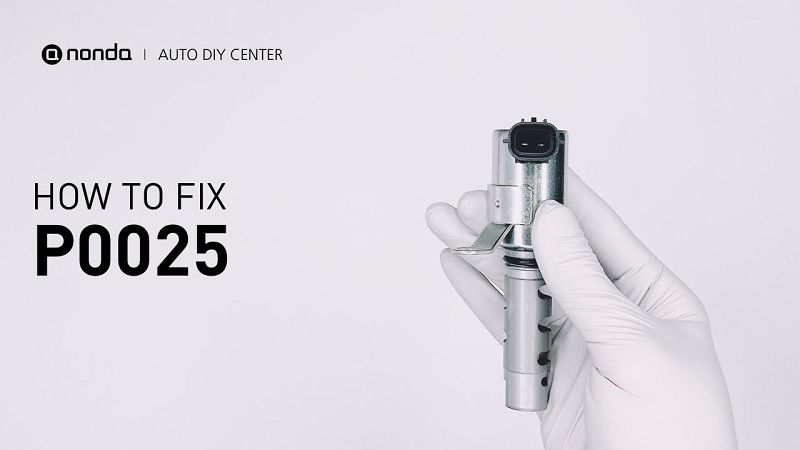This post contains affiliate links. This means I will make a commission at no extra cost to you should you click through and make a purchase [ “As an Amazon Associate, I earn from qualifying purchases.” ]. Read the full disclosure here.
Deciphering the P0025 Code: “B” Camshaft Position – Timing Over-Retarded (Bank 2) GuideMechanic.Com In the intricate world of automotive diagnostics, few things cause more trepidation than the sudden appearance of a check engine light.
Among the myriad of codes that can trigger this warning, the P0025 code is one that often perplexes both drivers and mechanics alike.
Denoting a “B” Camshaft Position – Timing Over-Retarded (Bank 2) issue, P0025 can signal potential trouble within a vehicle’s engine.
In this article, we’ll delve into the nuances of this diagnostic trouble code (DTC), exploring its meaning, potential causes, symptoms, and methods of resolution.
See Also: P0023 Code “B” Camshaft Position – Actuator Circuit (Bank 2)
P0025 Code “B” Camshaft Position – Timing Over-Retarded (Bank 2)
Unpacking the Basics

The P0025 code is a member of the On-Board Diagnostics II (OBD-II) system, a standardized system implemented in vehicles since the 1990s.
Its primary function is to monitor various components and systems within the vehicle, alerting drivers and technicians to potential malfunctions.
Specifically, P0025 pertains to the camshaft position, indicating that the timing of the camshaft on bank 2 (typically the side of the engine containing cylinder number 2) is over-retarded.
Identifying Symptoms

When the P0025 code manifests, drivers may notice a variety of symptoms, ranging from subtle to pronounced. These symptoms can include:
- Check Engine Light Illumination: The most immediate indication of a problem is the illumination of the check engine light on the vehicle’s dashboard.
- Decreased Engine Performance: The engine may exhibit reduced power, sluggish acceleration, or diminished fuel efficiency due to improper timing.
- Rough Idling or Stalling: Unstable idling or stalling may occur, particularly when the vehicle is at a standstill or operating at low speeds.
- Engine Misfires: Misfires, characterized by the failure of one or more cylinders to ignite fuel properly, may become more frequent.
Potential Causes

Several factors can contribute to the triggering of the P0025 code. These include:
- Faulty Camshaft Position Sensor: A malfunctioning camshaft position sensor can provide inaccurate data to the engine control module (ECM), resulting in timing issues.
- Variable Valve Timing (VVT) System Malfunction: Problems with the VVT system, including issues with the phaser or actuator, can lead to timing being over-retarded.
- Oil Flow Problems: Insufficient oil levels, degraded oil quality, or obstructions in oil passages can impede the proper operation of VVT components, affecting timing.
- Mechanical Timing Component Issues: Damage or wear to timing chains, tensioners, or other mechanical components can disrupt camshaft timing.
- ECM Software Glitches: In rare instances, bugs or glitches in the engine control module software may erroneously trigger the P0025 code.
Diagnosis and Resolution
Check out this ANCEL AD310 Classic Enhanced Universal OBD II Scanner Car Engine Fault Code Reader CAN Diagnostic Scan Tool-Black

Diagnosing and resolving a P0025 code typically requires a systematic approach, often involving the following steps:
- Code Reading: Utilize an OBD-II scanner to retrieve the stored trouble codes, including P0025, from the vehicle’s ECM.
- Visual Inspection: Conduct a visual inspection of the engine compartment, searching for visible signs of damage or leaks, particularly around the camshaft position sensor and VVT components.
- Camshaft Position Sensor Testing: Test the camshaft position sensor using a multimeter to ensure it is functioning within specified parameters.
- VVT System Inspection: Inspect the VVT system components, including the phaser, actuator, and oil passages, for signs of damage or malfunction.
- Oil Level and Quality Check: Verify that the engine has adequate oil levels and that the oil is clean and of the correct viscosity.
- Oil System Examination: Inspect the oil passages and system for obstructions or restrictions, ensuring proper oil flow to VVT components.
- Mechanical Component Inspection: If necessary, perform a thorough inspection of mechanical timing components, looking for wear, damage, or misalignment.
- Software Update: Consider updating the ECM software to the latest version provided by the manufacturer if all other potential causes are ruled out.
P0025 Code “B” Camshaft Position – Timing Over-Retarded (Bank 2)
Seeking Professional Assistance
While some automotive enthusiasts may attempt to diagnose and resolve P0025 issues independently, others may prefer to enlist the expertise of a qualified automotive technician.
These professionals possess the knowledge, tools, and resources necessary to accurately diagnose and address complex engine problems.
Conclusion
See Also: P0024 Code “B” Camshaft Position – Timing Over-Advanced or System Performance (Bank 2)
The P0025 code, indicating a “B” Camshaft Position – Timing Over-Retarded (Bank 2) issue, can be a source of concern for vehicle owners.
However, armed with a basic understanding of its causes and symptoms, as well as the diagnostic and resolution process, drivers can approach this problem with confidence.
Whether tackling it themselves or seeking professional assistance, addressing the underlying issues causing the P0025 code is crucial to restoring the vehicle’s performance and reliability.
- Catalytic Converter Cleaner Nearby - April 25, 2025
- BMW Catalytic Converter Price: What You Need to Know - April 24, 2025
- Scrap Catalytic Converter Price - April 24, 2025
